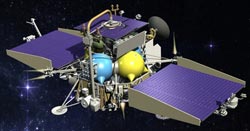Swedish instruments to study the Martian atmosphere in collaboration with Russia and China

Phobos-Grunt<br>Image: IKI<br>
The dual spacecraft is scheduled to arrive at Mars in October 2012. After insertion into orbit the two spacecraft will separate. Yinghuo-1 will stay on a highly elliptical orbit (800km x 80,000 km), whereas Phobos-Grunt will enter a more circular orbit in order to approach and land on the Martian moon Phobos.
The Swedish Institute for Space Physics (IRF) in Kiruna has provided three identical ion mass analysers for this mission. The Detector for Ions at Mars (DIM) is mounted on the main Phobos-Grunt spacecraft. The DIM sensor was developed and built at IRF, while the associated digital processing unit was built at the Russian Space Research Institute (IKI).
Yinghuo-1 carries a plasma package (Yinghuo Plasma Package, YPP) consisting of two ion mass analysers and an electron sensor. The package is a joint development between IRF and the National Space Science Center (NSSC) in China. IRF developed and built the ion mass analysers (YPP-i1 and YPP-i2), while NSSC has provided the associated digital processing units and the electron sensor. The Space Research Institute (IWF) in Graz, Austria, participates in the scientific aspects of the Yinghuo Plasma Package.
All three ion sensors will simultaneously investigate the interaction between the solar wind (a stream of charged particles from the sun) and the Martian atmosphere from different vantage points in space.
“We already have the ASPERA-3 instrument orbiting Mars on the European spacecraft Mars Express,” says Dr Martin Wieser of IRF. “With all of these instruments in place we will be able to do multi-point plasma measurements from orbiting spacecraft for the first time at Mars.”
Martin Wieser adds, “And thanks to Yinghuo's elliptical orbit, the Yinghuo Plasma Package will be able to explore the distant plasma tail of Mars — another first.”
More information:
Dr Martin Wieser, scientist and project leader, IRF, tel. +46-980-79198, martin.wieser*irf.se
Rick McGregor, Information Officer, IRF, tel. +46-980-79178, rick.mcgregor*irf.se
Media Contact
All latest news from the category: Physics and Astronomy
This area deals with the fundamental laws and building blocks of nature and how they interact, the properties and the behavior of matter, and research into space and time and their structures.
innovations-report provides in-depth reports and articles on subjects such as astrophysics, laser technologies, nuclear, quantum, particle and solid-state physics, nanotechnologies, planetary research and findings (Mars, Venus) and developments related to the Hubble Telescope.
Newest articles

Silicon Carbide Innovation Alliance to drive industrial-scale semiconductor work
Known for its ability to withstand extreme environments and high voltages, silicon carbide (SiC) is a semiconducting material made up of silicon and carbon atoms arranged into crystals that is…

New SPECT/CT technique shows impressive biomarker identification
…offers increased access for prostate cancer patients. A novel SPECT/CT acquisition method can accurately detect radiopharmaceutical biodistribution in a convenient manner for prostate cancer patients, opening the door for more…

How 3D printers can give robots a soft touch
Soft skin coverings and touch sensors have emerged as a promising feature for robots that are both safer and more intuitive for human interaction, but they are expensive and difficult…





















